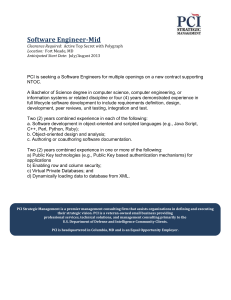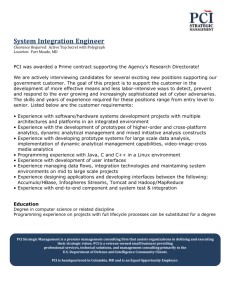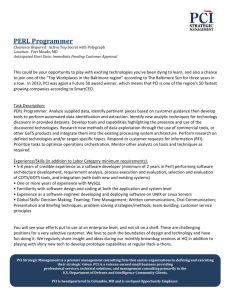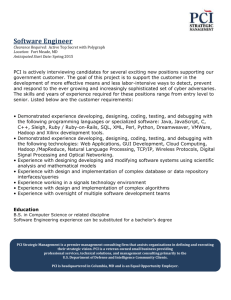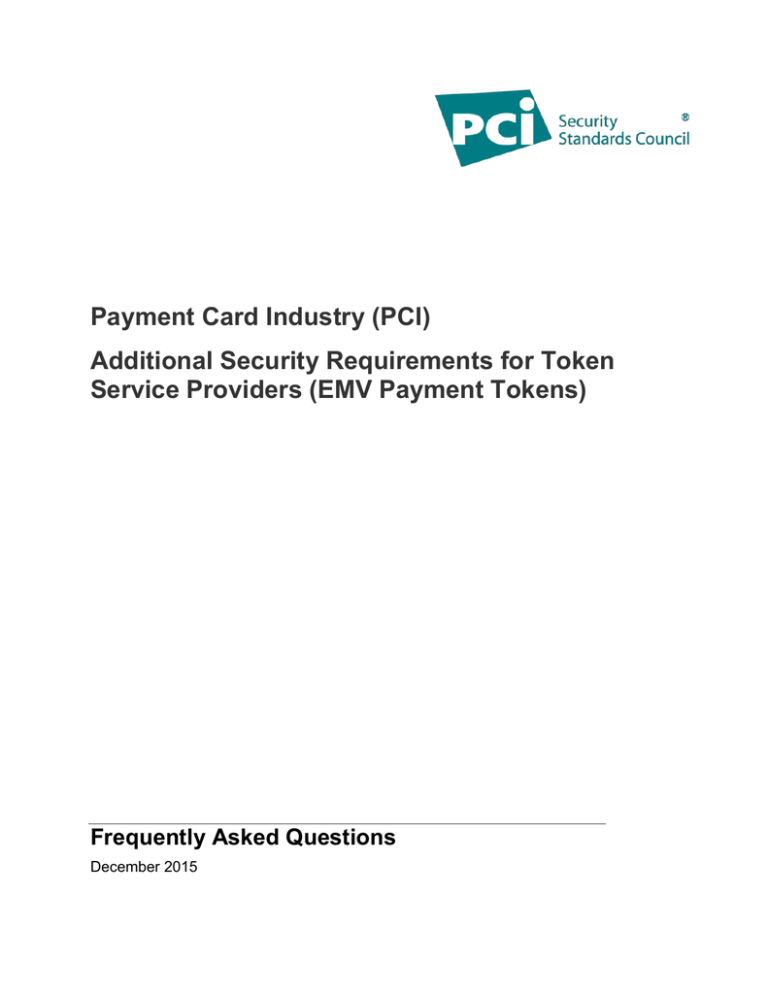
Payment Card Industry (PCI)
Additional Security Requirements for Token
Service Providers (EMV Payment Tokens)
Frequently Asked Questions
December 2015
Introductory Note
This document addresses frequently asked questions (FAQs) related to the PCI SSC Additional Security
Requirements and Assessment Procedures for Token Service Providers (EMV Payment Tokens), Version
1.0. Throughout this FAQ document:
The use of “PCI TSP Security Requirements” refers to the Additional Security Requirements and
Assessment Procedures for Token Service Providers (EMV Payment Tokens) Version 1.0, as
published on the PCI SSC website (www.pcisecuritystandards.org).
The use of “EMVCo Technical Framework” refers to the EMV® Payment Tokenisation
Specification – Technical Framework, as published by EMVCo (www.emvco.com).
“TSP” is a PCI SSC-defined acronym that refers to and aligns with the EMVCo-defined term
“Token Service Provider”
Further information about use and applicability of the PCI TSP Security Requirements can be found in
the “Introduction”, “Terminology”, and “Scope of Requirements” sections within the document itself.
FAQs for PCI TSP Security Requirements
Q 1. Who is required to comply with the PCI TSP Security Requirements?
A:
Compliance programs for the PCI TSP Security Requirements, including which entities need to
validate and validation procedures, are managed by the payment brands. Entities that are
registered as Token Service Providers by EMVCo should confirm their compliance and validation
requirements with the applicable payment brand(s).
Q 2. When are the PCI TSP Security Requirements effective?
A:
The TSP Security Requirements are active upon publication. Effective dates for compliance to TSP
Security Requirements are defined by the payment brands. Any queries about validating
compliance to the TSP Security Requirements should be directed to the applicable payment
brand(s).
Q 3. What is the relationship between PCI DSS and the PCI TSP Security Requirements?
A:
The PCI TSP Security Requirements build on and are additional to those in PCI DSS. Both the PCI
DSS and TSP Security Requirements apply to the TSP’s token data environment.
Q 4. What is the relationship between the EMVCo Technical Framework and the PCI TSP Security
Requirements?
A:
The EMVCo Technical Framework defines technical requirements for interoperable tokenization
solutions for Payment Tokens. The specification defines the key roles and data fields associated
with Payment Token requests, issuance, provisioning, transaction processing, and application
programming interfaces (APIs).
The PCI TSP Security Requirements define physical and logical security controls to protect the
environments where Token Service Providers (as defined by the EMVCo Technical Framework)
perform tokenization services.
FAQs for PCI TSP Security Requirements v1.0
© 2015 PCI Security Standards Council, LLC. All Rights Reserved
Page 2
December 2015
During development of the PCI TSP Security Requirements, PCI SSC consulted with EMVCo to
produce requirements that support and complement the EMVCo Technical Framework.
Supporting programs for the PCI TSP Security Requirements and EMVCo Technical Framework
are managed by PCI SSC and EMVCo respectively, and each entity defines its own processes and
procedures related to their own program. The documents are independently maintained, and
neither document replaces or supersedes the other.
Q 5. Do the PCI TSP Security Requirements apply to acquiring tokens?
A:
No. The PCI TSP Security Requirements are intended for entities that have registered with EMVCo
as a Token Service Provider for Payment Tokens. The PCI TSP Security Requirements cover
Payment Tokens as defined by EMVCo, and do not address acquiring tokens or other types of
tokens. While entities that provide services for acquiring tokens (for example, by tokenizing PAN
after it is received from the cardholder during a transaction) may choose to implement the PCI
TSP Security Requirements, they are not required to do so.
For guidance on acquiring token solutions, the PCI Tokenization Product Security Guidelines
document is available on the PCI SSC website.
Q 6. What is the difference between “acquiring tokens”, “issuer tokens”, and “Payment Tokens”?
A:
Each of these types of tokens replace the PAN with an alternative or surrogate value.
Acquiring tokens are created by the acquirer, merchant, or a merchant’s service provider after
the cardholder presents their PAN and/or other payment credentials. Acquiring tokenization
solutions are proprietary and are not based on an industry-standard approach to token
generation, format, request or provisioning1. Acquiring Tokens cannot be used for new
authorizations. They can be used for card-on-file and recurring payments. The PCI Tokenization
Product Security Guidelines offers guidance on acquiring tokens.
Issuer tokens, also known as virtual card numbers, are created by issuers and provide the means
to reduce risk in specific use cases, including commercial card applications, as well as consumeroriented services. These tokens resemble the PAN, so merchants and acquirers are unlikely to
know that they are using a token2.
Payment tokens are created by TSPs that are registered with EMVCo. Payment Tokens and their
usage are defined by EMVCo in the EMVCo Technical Framework. Payment Tokens are issued to
a cardholder in lieu of a PAN, and the cardholder presents the Payment Token to the merchant
when making a purchase. During a Payment Token transaction, the merchant and acquirer do
not receive or have access to the corresponding PAN.
1
U.S. Payments Security Evolution and Strategic Road Map. Developed by the working groups of the Payments Security
Taskforce, December 11, 2014.
2
U.S. Payments Security Evolution and Strategic Road Map. Developed by the working groups of the Payments Security
Taskforce, December 11, 2014.
FAQs for PCI TSP Security Requirements v1.0
© 2015 PCI Security Standards Council, LLC. All Rights Reserved
Page 3
December 2015
Q 7. How do the PCI TSP Security Requirements differ from the PCI Tokenization Product Security
Guidelines?
A:
The PCI TSP Security Requirements is a standard for Payment Tokens, while the PCI Tokenization
Product Security Guidelines provide guidance and best practices for acquiring tokens
The PCI TSP Security Requirements are intended for entities designated by EMVCo as Token
Service Providers, to protect the environments where the Token Service Provider performs
tokenization services. Assessment and validation against the TSP Security Requirements may be
required by payment brands for registered Token Service Providers.
The Tokenization Product Security Guidelines were published by PCI SSC in April 2015 to provide
technical best practices for the development of tokenization solutions for acquiring tokens. The
Tokenization Product Security Guidelines do not apply to Payment Tokens and are not intended
for use by Payment Token TSPs. The Tokenization Product Security Guidelines are intended as
guidance only; there is no program or validation associated with the Guidelines.
Q 8. Where do the PCI TSP Security Requirements apply within a TSP’s environment?
A:
The PCI TSP Security Requirements apply to the TSP’s token data environment, which is a
dedicated, secure area within which the TSP performs the tokenization services defined in the
EMVCo Technical Framework. The token data environment is described further within the PCI TSP
Security Requirements. Payment Tokens that exist outside of the token data environment are not
subject to the PCI TSP Security Requirements.
Q 9. How does a TSP validate to the PCI TSP Security Requirements?
A:
Entities wishing to become Token Service Providers must first register with EMVCo and meet all
requirements defined in the EMVCo Technical Framework.
To validate to the PCI TSP Security Requirements, the TSP engages a QSA (P2PE) to evaluate the
token data environment against the PCI TSP Security Requirements. The TSP submits validation
documentation (ROC and AOC) to the applicable payment brand(s). Templates for the TSP ROC
and TSP AOC are provided on the PCI SSC website.
Q 10. Who is qualified to assess the PCI TSP Security Requirements?
A:
When assessing the TSP’s token data environment, only QSA (P2PE)s that have undergone TSP
training are qualified to assess the PCI TSP Security Requirements. PCI DSS Requirements 1
through 12 (which also apply to the token data environment) may be validated by a QSA.
Q 11. Why is a QSA (P2PE) required to assess the PCI TSP Security Requirements?
A:
The PCI TSP Security Requirements include cryptographic key management, physical security and
logical access controls that are more stringent than PCI DSS. Assessment of these requirements
requires a level of knowledge and skill comparable to that required for performing P2PE
assessments. Qualification as a QSA (P2PE) requires a level of prerequisite experience and
knowledge that is also suitable for assessing the more stringent controls defined in the PCI TSP
Security Requirements.
FAQs for PCI TSP Security Requirements v1.0
© 2015 PCI Security Standards Council, LLC. All Rights Reserved
Page 4
December 2015
Q 12. How can a QSA that is not also a QSA (P2PE) become qualified to assess the PCI TSP Security
Requirements?
A:
QSAs that wish to assess the PCI TSP Security Requirements, and that meet all the requisite
personnel and company requirements defined in the “PCI Qualification Requirements For Pointto-Point Encryption (P2PE) Qualified Security Assessors – QSA (P2PE) and PA-QSA (P2PE)”, can
follow the qualification path to become a QSA (P2PE) in order to perform such assessments.
Q 13. When will qualified assessors be available to perform TSP Security Requirements assessments?
A:
PCI SSC will publish reporting templates and provide QSA (P2PE)s with supplemental training in
early 2016. Additional announcements and communications will be provided when these are
available.
Q 14. Does PCI SSC list validated TSPs?
A:
There are currently no plans for PCI SSC to list Token Service Providers that have been assessed
to the PCI TSP Security Requirements. Any queries about TSP compliance should be directed to
the applicable payment brand(s).
FAQs for PCI TSP Security Requirements v1.0
© 2015 PCI Security Standards Council, LLC. All Rights Reserved
Page 5
December 2015

